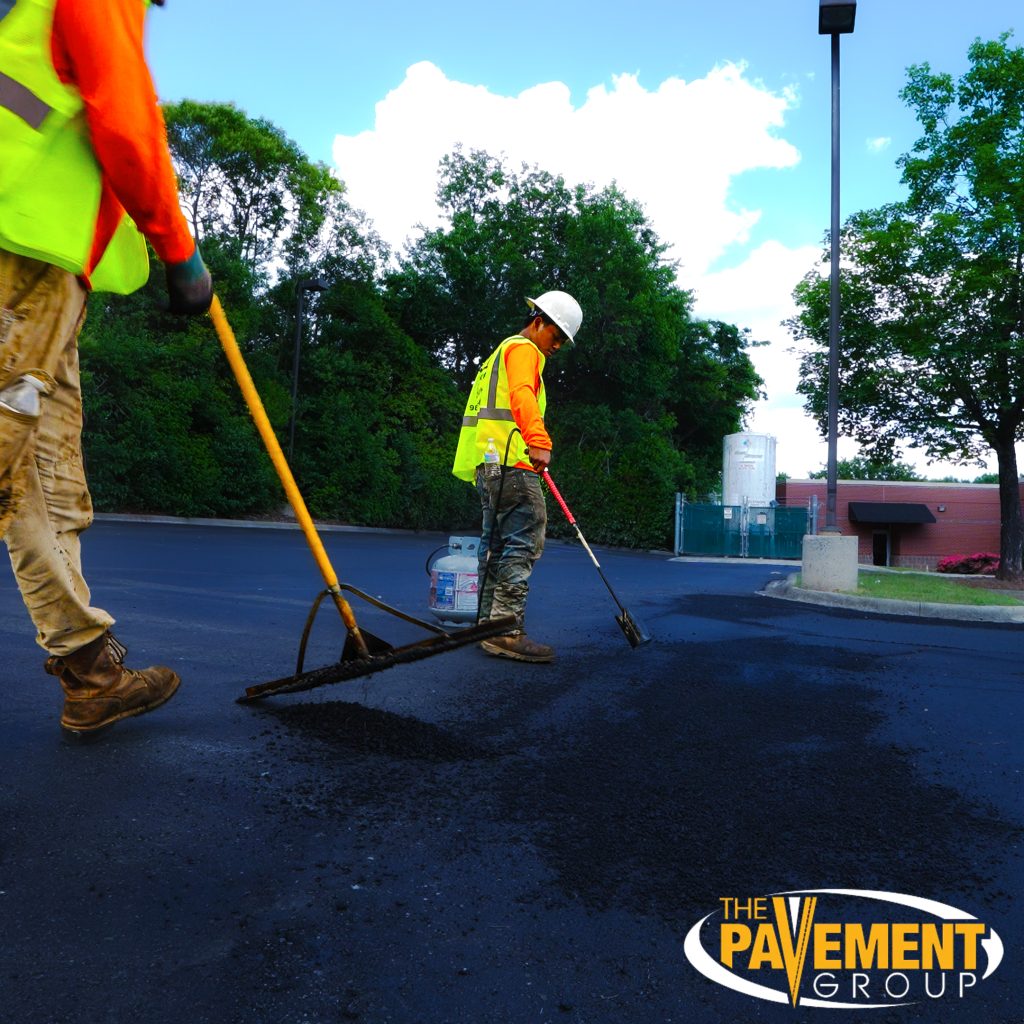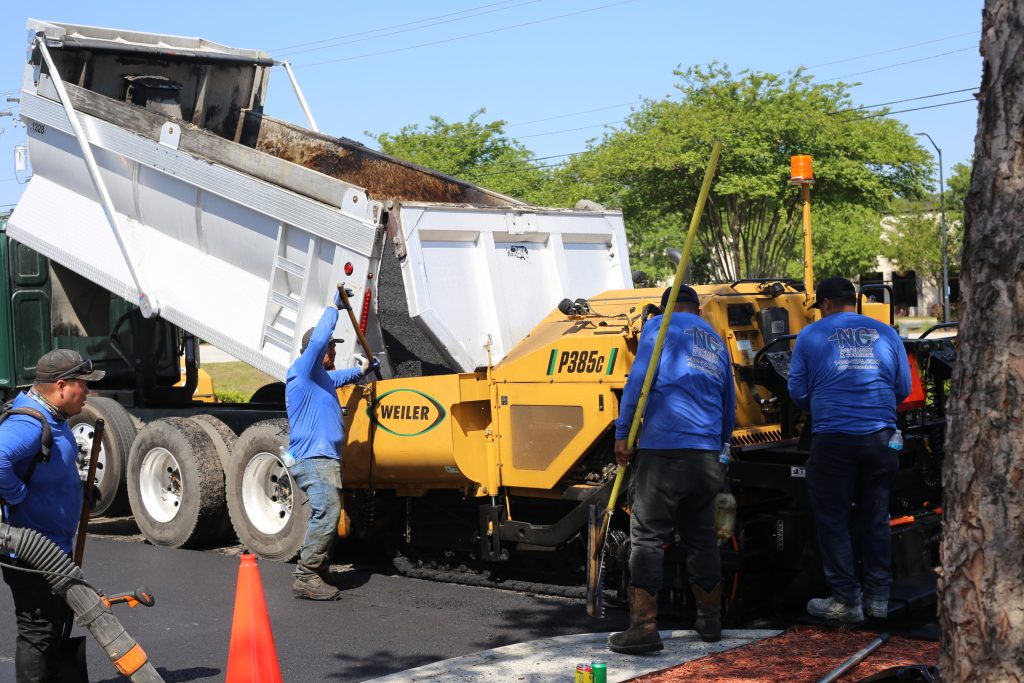Managing pavement in industrial complexes is more than an occasional repair job. It’s a year-round responsibility that directly affects safety, operational flow, and long-term property value. Seasonal changes create different challenges for asphalt and concrete surfaces, from winter freeze–thaw cycles to summer heat expansion. That’s why implementing a seasonal pavement maintenance plan for industrial complexes is essential for facility managers who want predictable upkeep, lower repair costs, and safer environments.
This guide breaks down a complete, season-by-season maintenance strategy that keeps your pavement performing smoothly and helps you plan ahead; rather than react to costly emergencies.
Why Industrial Complexes Need a Seasonal Pavement Plan
Industrial pavement is not like standard commercial or residential pavement. It handles:
- Heavy-duty trucks
- Forklifts and industrial vehicles
- Continuous loading and unloading
- High-volume traffic
- Weather exposure and chemical spills
Because of these conditions, industrial pavement deteriorates faster unless it receives consistent, strategic care. A seasonal plan allows managers to anticipate repairs, prevent emergencies, and maintain compliance with safety standards.
Spring: Assessment and Early Repairs
Conduct a Complete Post-Winter Inspection
Spring is the ideal time to inspect the pavement after winter damage. Freeze–thaw cycles often cause cracks, lifting, and early pothole formation. Identifying issues early prevents small cracks from expanding into major structural failures. A thorough inspection sets the stage for the entire maintenance year.
Clean and Clear Debris
Leaves, dirt, and accumulated winter debris block drainage systems and lead to standing water. Early spring cleaning also helps expose hidden cracks and problem spots. Pressure washing is often recommended for industrial complexes with large traffic areas. Clean pavement allows repairs to bond better and last longer.
Prioritize Crack Filling and Pothole Repair
Spring is the most cost-effective season for surface-level repairs. Crack filling prevents water from seeping beneath the pavement, which reduces future structural damage. Pothole patching helps ensure safer driving conditions and smoother operations. Addressing these early keeps the pavement strong through the summer heat.
Summer: Sealcoating and Surface Protection
Schedule Sealcoating During Warm Weather
Sealcoating protects asphalt from UV rays, oil leaks, chemicals, and rainfall. Summer temperatures allow the material to cure properly and create a strong, protective barrier. Industrial complexes benefit from sealcoating because it improves appearance and extends pavement life. It also reduces long-term maintenance costs.
Evaluate and Improve Pavement Markings
Summer is the best time to refresh worn-out striping and directional markings. Clear markings help control traffic flow and enhance employee and visitor safety. Industrial areas rely heavily on visibility for loading zones, delivery areas, and pedestrian walkways. Updated markings also support regulatory compliance.
Strengthen Drainage Systems
Summer storms can overwhelm industrial drainage if not maintained. Ensuring catch basins, gutters, and drains are functioning prevents water pooling and surface erosion. Strong drainage systems prevent water from weakening the pavement structure. This creates a more resilient surface heading into fall.
Fall: Preparation for Cold Weather
Repair Any Late-Season Damage
Even minor cracks and surface issues should be addressed before winter arrives. Left untreated, these imperfections expand due to freezing temperatures. Fall repairs help stabilize the pavement structure during the harshest seasonal conditions. This is a critical time for industrial complexes due to heavy holiday traffic and increased transport activity.
Apply Protective Treatments
Some industrial sites apply a second layer of sealant to high-traffic zones. Fall is also a good time to reinforce edges and joints, which are vulnerable to winter stress. These preventative steps reduce the frequency of emergency repairs in the colder months. Strong protection equals fewer disruptions for your operations.
Ensure Salt and De-Icing Plans Are Ready
Industrial complexes need reliable snow and ice management routines. Surface-safe de-icing products prevent long-term pavement deterioration. Preparing equipment in advance ensures winter storms don’t interfere with operations. A strong plan saves time, labor, and repair expenses.
Winter: Monitoring and Damage Control
Minimize Use of Harsh Chemicals
Industrial complexes often rely on de-icers, but not all are pavement-friendly. Choosing the right products prevents premature cracking and deterioration. Winter maintenance should always balance safety with pavement preservation. Avoiding aggressive chemicals extends the lifespan of your pavement surface.
Watch for Freeze–Thaw Damage
Winter creates instability beneath the pavement. Monitoring the surface helps you spot new cracks or uplift early before they worsen. Keeping walkways and driving paths clear prevents accidents and further pavement damage. Quick response is key to long-term durability.
Maintain Clear Drainage Paths
Snow and ice can block drainage systems. Keeping them clear reduces water accumulation during thaw cycles. Proper drainage reduces erosion and prevents the formation of deep potholes. Winter drainage management supports spring recovery.
Long-Term Benefits of a Seasonal Pavement Maintenance Plan
Implementing a seasonal pavement maintenance plan for industrial complexes helps:
- Extend pavement lifespan by years
- Reduce emergency repair costs
- Improve safety and accident prevention
- Maintain a professional industrial environment
- Reduce operational downtime
- Increase property value
Preventive care always costs less than major reconstruction. A seasonal approach ensures your pavement remains strong, functional, and cost-efficient year-round.
Start Protecting Your Pavement Year-Round
Don’t wait for cracks and potholes to disrupt your operations. Take control of your pavement’s lifespan today. A strong seasonal pavement maintenance plan for industrial complexes keeps your property safe, efficient, and professional year-round. Contact The Pavement Group to schedule your pavement maintenance. Protect your investment now and keep your industrial complex running smoothly through every season.
Frequently Asked Questions
1. What is a seasonal pavement maintenance plan for industrial complexes?
A seasonal pavement maintenance plan outlines year-round tasks to protect and preserve industrial pavement. It focuses on weather-specific inspections, repairs, and preventative treatments. This approach reduces long-term damage and unexpected costs. It also ensures safety and uninterrupted industrial operations.
2. Why is seasonal pavement care important for industrial properties?
Seasonal care addresses climate-related damage that affects pavement durability. Industrial complexes endure heavy loads and traffic, making maintenance even more essential. Regular upkeep reduces emergencies and extends pavement life. A structured plan helps facility managers stay ahead of repairs.
3. What pavement issues should be inspected in spring?
Spring inspections typically focus on cracks, potholes, and drainage issues caused by winter freezing. Freeze–thaw cycles often weaken pavement structures. Early detection prevents minor issues from becoming major repairs. Spring assessments guide maintenance tasks for the entire year.
4. How does summer weather impact industrial pavement?
Hot temperatures can soften asphalt and accelerate surface aging. UV rays also weaken the pavement binder. High heat makes industrial traffic more stressful on the pavement surface. This season is ideal for protective treatments like sealcoating.
5. Why is sealcoating important for industrial complexes?
Sealcoating shields the pavement from sunlight, chemicals, oils, and moisture. It helps maintain surface strength and visual appeal. Industrial sites benefit from reduced wear in high-traffic zones. Sealcoating significantly extends the overall life of asphalt surfaces.
6. What fall maintenance tasks should industrial properties prioritize?
Fall is the time to repair cracks, patch damage, and reinforce weak areas. Preparing pavement before winter prevents freeze-related deterioration. Drainage systems should also be checked to avoid cold-weather blockages. Fall preparation reduces costly repairs later.
7. How does winter weather damage pavement?
Winter causes freeze–thaw cycles that expand cracks and weaken pavement layers. Snow, ice, and moisture can seep into vulnerable areas. Heavy equipment movement during icy conditions makes damage worse. Winter monitoring helps prevent structural failures.
8. What role does drainage play in pavement maintenance?
Good drainage prevents standing water that leads to erosion and cracking. Proper flow channels protect the pavement’s foundation. Industrial complexes rely on drainage to handle heavy runoff. Strong drainage increases pavement longevity.
9. How often should industrial pavement be inspected?
Most industrial properties benefit from quarterly or seasonal inspections. Frequent evaluations identify early damage and safety concerns. Regular inspections support long-term pavement performance. They also reduce unexpected repair expenses.
10. Can preventative pavement maintenance reduce long-term costs?
Yes, routine care prevents deteriorating issues from becoming expensive repairs. Well-maintained pavement lasts significantly longer. Preventative steps minimize operational disruptions. This leads to better budgeting and lower total lifecycle costs.


